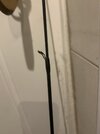Ian Woods
Senior Member
I disagree with nearly all of that, It doesn’t work like you describe at all.
If your trotting a top n bottom float in most situations your holding it back and reducing its pace in order to kick the bait out infront and create a more natural speed to what the current is like at the bottom.
This means you have a relatively tight line to your float and in lot of situations if you can keep the line very direct to the float you feel the bite through the rod as the float is rammed under. All you need is to pull that hook afew mm’s and it’s in.
A short sharp whip of the rod tip is just as effective, trust me if I was losing or missing fish because of this i wouldn’t continue
Id be up for testing this with any doubters by letting them hold the hook at 60 yards and seeing just for themselves how little pressure is needed from me holding the other end and waiting for the “ow ow ow ow “
I’m not expecting many volunteers
If your line is performing large S shapes down the river then yes all your going to do is pick up the slack on the strike and perform quite poorly at hitting home.
If I’m using a spliced tip rod I will whip that tip back to hit fish. It’s difficult to describe but you kind of preload the tip and whip it back with your wrist. My forearm stays straight. and I’ll do it faster than an across the body sweep with a hollow tip rod
With as much line off the water as possible and a reduced pace float, it’s waaaaaaaaay more than enough force to drive hooks from as far as my eyes will let me see a float.
Mmm, you see I try to avoid fishing my line too tight to the float. By the time you feel the little tug at the rod end many a fish will have already spat out the bait having felt the tight line to the float.
That's another reason people think they have bumped fish off, they just haven't hooked the fish properly.
All the talk of bumping fish off because the rod is too harsh is nonsense really....imo. The reason I say that is because, if a fish is hooked propperly you could strike hard enough to drag it up and out of the water without the hook coming free.
More often than not I have to fish 20 to 30yds across the flow and it's quite impossible to fish a tight line direct to the float as the float would be pulled off line and back across the flow. To stop this from happening I use severl little tricks, if the wind is upstream that is handy to control the float across the flow. I can't explaine how in writing though.
Very rarely do I fish how you describe, holding back so my bait rises up in the water. I hold back most of the time, but my bait is usually dragging bottom and i'm holding back to allow a bow from the float to the bait so the bait is level pegging with the float as they move down the river. That method also stops your float from being dragged under. You might call it controlled dragging bottom lol.
Regarding striking faster with a spliced rod, I don't think so. To my way of thinking a hollow tipped rod which has the same kind of stiffness in the lower and mid sections it will have a faster strike. The reason I say that is because the hollow tip will not fold over as easy as a spliced tip so has to be faster....imo.
I have found this to be right in practice also, so not just an opinion in my head.
There is no doubt that you can catch decent sized fish with a spliced tipped rod, I have caught barbel by design using a browning sphere spliced rod and it was adequate, but not as nice to use to catch them as my spere waggler rods.
I'd much prefer to catch them on the drennan acolyte plus or even better still, the specimen accy float rod.
All the above is my own findings and opinions using my style of trotting, i'm not trying to tell anyone how to fish...you do what you do






